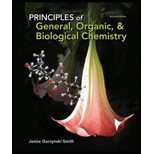
Interpretation:
The molecular art that represents a solution of potassium iodide in water has to be identified. The reason has to be explained and conduction of electricity by the solution has to be predicted.
Concept Introduction:
A substance that conducts electricity in water is called as electrolyte and substance that does not conduct electricity in water is called as nonelectrolyte.
Strong electrolyte: An electrolyte that completely dissociates to form ions, when it dissolves in water is called as strong electrolyte.
Weak electrolyte: An electrolyte in which molecules (a small fraction) forms ions, when dissolves in water to give largely uncharged molecules is called as weak electrolyte.
Explanation of Solution
Potassium iodide is an ionic compound, hence separation of ions will takes place when they are dissolved in water.
Figure A represents the solution of potassium iodide in water because the ions of potassium and iodine are separated when potassium iodide is dissolved in water. Yes, the solution of potassium iodide in water conducts electricity due to the presence of ions. Hence, it is best molecular art representation of potassium iodide solution in water.
Figure B represents the molecule of potassium iodide (without being separated into ions). Hence, it cannot be correct representation.
Want to see more full solutions like this?
Chapter 7 Solutions
Principles of General Organic & Biological Chemistry
- What does it mean to say that mercury (II) halides are weak electrolytes?arrow_forwardWhat mass of HCl is contained in 45.0 mL of an aqueous HCl solution that has a density of 1.19 g cm-3 and contains 37.21% HCl by mass?arrow_forward94. Baking soda (sodium hydrogen carbonate. NaHCO3) is often used to neutralize spills of acids on the benchtop in the laboratory. What mass of NaHCO3 would be needed to neutralize a spill consisting of 25.2 mL of 6.01 M hydrochloric acid solution?arrow_forward
- What mass of a 4.00% NaOH solution by mass contains 15.0 g of NaOH?arrow_forwardYou wish to prepare 1 L of a 0.02-M potassium iodate solution. You require that the final concentration be within 1% of 0.02 M and that the concentration must be known accurately to the fourth decimal place. How would you prepare this solution? Specify the glassware you would use, the accuracy needed for the balance, and the ranges of acceptable masses of KIO3 that can be used.arrow_forwardPhysiological saline concentration—that is, the sodium chloride concentration in our bodies—is approximately 0.16 M . A saline solution fur contact lenses is prepared to match the physiological concentration. If you purchase 25 mL of contact lens saline solution, how many grams of sodium chloride have you bought?arrow_forward
 Introductory Chemistry: A FoundationChemistryISBN:9781337399425Author:Steven S. Zumdahl, Donald J. DeCostePublisher:Cengage Learning
Introductory Chemistry: A FoundationChemistryISBN:9781337399425Author:Steven S. Zumdahl, Donald J. DeCostePublisher:Cengage Learning World of Chemistry, 3rd editionChemistryISBN:9781133109655Author:Steven S. Zumdahl, Susan L. Zumdahl, Donald J. DeCostePublisher:Brooks / Cole / Cengage Learning
World of Chemistry, 3rd editionChemistryISBN:9781133109655Author:Steven S. Zumdahl, Susan L. Zumdahl, Donald J. DeCostePublisher:Brooks / Cole / Cengage Learning Chemistry by OpenStax (2015-05-04)ChemistryISBN:9781938168390Author:Klaus Theopold, Richard H Langley, Paul Flowers, William R. Robinson, Mark BlaserPublisher:OpenStax
Chemistry by OpenStax (2015-05-04)ChemistryISBN:9781938168390Author:Klaus Theopold, Richard H Langley, Paul Flowers, William R. Robinson, Mark BlaserPublisher:OpenStax ChemistryChemistryISBN:9781305957404Author:Steven S. Zumdahl, Susan A. Zumdahl, Donald J. DeCostePublisher:Cengage Learning
ChemistryChemistryISBN:9781305957404Author:Steven S. Zumdahl, Susan A. Zumdahl, Donald J. DeCostePublisher:Cengage Learning
 Chemistry: An Atoms First ApproachChemistryISBN:9781305079243Author:Steven S. Zumdahl, Susan A. ZumdahlPublisher:Cengage Learning
Chemistry: An Atoms First ApproachChemistryISBN:9781305079243Author:Steven S. Zumdahl, Susan A. ZumdahlPublisher:Cengage Learning





